|
|
|
Production Notes - Licence To
Kill
With The Living Daylights still on general
release and doing less well than anyone might have hoped, EON
set about preparing the next
Bond adventure. Licence To Kill was going
to break with the Bond tradition in a number of ways. First of
all it was the first EON
Bond film not to take at least part of its title from a Fleming
original - the only Fleming titles still unused were the short
stories
Quantum of Solace, Risico and The Hildebrand Rarity [all 1960]
and The Property of a Lady [1963], none of which were then deemed
suitably
cinematic.
The other major departure from tradition was that
for only the second time [Moonraker [1979]
was the first], the new Bond film would not be made at its traditional
home at Pinewood studios
- indeed the series would not film there again until 1999's The
World is Not Enough. EON had decided that with the recent
abolition of the Eady Levy and new tax laws which taxed foreign
artists
at source and disallowed the traditional writing off of 100%
of their costs against tax, it was simply no longer financially
viable to shoot in the UK. EON's accountants had worked out
that,
factoring in the currently weak dollar, EON would have to add
10% more to their outlay if they were to stay at Pinewood.
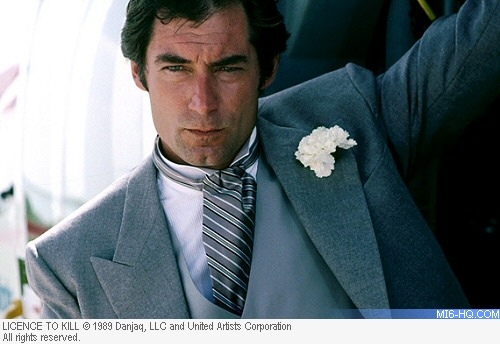
Above: Timothy Dalton as James
Bond in the pre-credits sequence.
|
With no storyline yet in place to dictate
where the film should be set, EON were more or less free to
pick and choose a new base
for their operations. China was the first choice and EON representatives
visited the country in November and December of 1987 to scout
for likely locations.
|
But John Glen, returning for his fifth
and final stint as Bond director, was less than keen to
use China as the setting for the film. The Last Emperor
[1988] had only recently finished shooting there and the
obvious attractions of using a location that was still
largely unknown to western audiences had lost some of its
appeal.
Douglas Noakes, who was already on board
the project as an accountant, came up with the alternative
- Churubusco Studios in Mexico City, then a hotbed of
activity thanks to favourable tax breaks and low wages.
It seemed
the ideal choice and EON prepared to up sticks and move,
leaving only its post-production and editing teams at Pinewood.
The next step was to get a script written.
Long-time Bond scribe Richard Maibaum was prevented from
contributing
to the script due to a Writer's Guild of America dispute,
but he did collaborate with Michael
G. Wilson on an outline
that Wilson was to develop into a script on his own,
titled at that time Licence Revoked.
There was precious little of Fleming in the finished product,
save a few characters and situations mixed and matched from
a couple of stories.
|
|
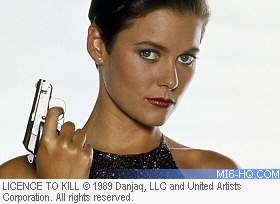
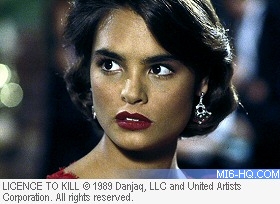
Above: The leading ladies of "Licence
To Kill" - Carey Lowell (top)
and Talisa Soto.
|
Milton
Krest had first appeared in The Hildebrand
Rarity; and the scene where Leiter is fed to
the sharks, his mutilated body
dumped at Bond's hotel room with the note "He disagreed
with something that ate him" came from Live and Let Die. Wilson set to work on the new script - which was to make the
most of the Mexico locations - tailoring it much more to Timothy
Dalton's persona than he and Maibaum had been able to do on The
Living Daylights, when it was still unclear who was going to
play Bond. Casting presented few problems for producer Albert
R. Broccoli and his team. Only the casting
of former model Carey Lowell raised a few eyebrows. Lowell's
most recent film had been the oddball
comedy Me and Him about a talking penis and Bond's distributor,
Columbia, were unsure about the wisdom of casting someone who
had appeared in such a film. Their nerves soon calmed however
and Lowell won the part of tough talking CIA agent Pam Bouvier.
Bond's other girl this time was the apparently insatiable Lupe
Lamora, played by former Miss Galaxy Talisa
Soto.
|
The new villain was to be played by Robert
Davi, hot off the set of Die Hard [1988] but still
best known for his occasional appearances on TV's Hill
Street
Blues. The former opera singer came to the attention of
Broccoli after a recommendation from Richard Maibaum.
He was to ably assisted by veteran TV and stage actor Anthony
Zerbe whose film career CV featured such hits as Papillon
[1973] and Rooster Cogburn [1975].
David Hedison returned to the series to
reprise the role of CIA agent turned DEA agent Felix
Leiter.
Hedison had
played the role once before, opposite Roger
Moore in Live
And Let Die and became the first actor to play the
character more than once. Other familiar faces returning
to the series were
Robert Brown as M and Caroline Bliss as Moneypenny, Licence
To Kill marking the swan song in the series for both actors.
But the show is all but stolen by the redoubtable Desmond
Llewelyn whose Q not only handed out the goodies to Bond
this time, but also joined him in the field, giving Llewelyn
a rare chance to venture beyond Pinewood. His extended
appearance raised the rafters at the London press screening
and Llewelyn later noted that this was the first time that
he'd made any real money out of the Bond films! |
|
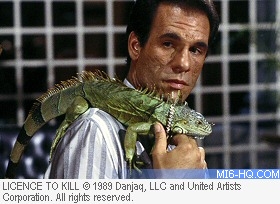
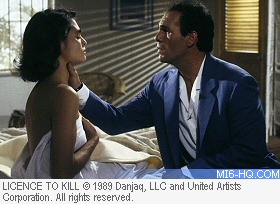 Above:
Sanchez and his pet iguana (top) and a scene from the
pre-credits sequence when he finds his girlfriend Lupe
in another man's bed. Above:
Sanchez and his pet iguana (top) and a scene from the
pre-credits sequence when he finds his girlfriend Lupe
in another man's bed.
|
On Monday 18 July 1988, the EON crew moved in to Churubusco -
where it had taken over seven of its eight sound stages - and
shooting began. Most of the location work was confined to the
surrounding areas, the crew touching down at Vera Cruz, Durango
and Temoaya. The casino at Isthmus City was doubled by the Casino
Espagnol, a large social club for Spanish ex-patriots - no casinos
exist in Mexico where gambling is illegal.
In August, the crew moved on to
Key West off Florida where the pre-credits sequence
was shot. The aerial crew, based at nearby
Sugarloaf Key Airport, was coordinated by an old friend of the
series, Corkey Fornhof, who had brought both his
skills and his
Acrostar
aircraft to Octopussy [1983]. When Bond hands reluctantly hands over his weapons and his license
to kill to M, the impressive building they are standing in was
once the home to writer Ernest Hemingway - thus making Bond's
quip about "a farewell to arms" all the more resonant.
|
An underwater crew laboured long and hard off the Isla
Mujeres near Cancun while the second unit, supervised by
another Bond veteran, Remy Julienne, staged the incredible
truck stunts seen in the film's climax. For seven weeks
Julienne and his crew toiled away in the sweltering heat
of lonely desert roads near Mexicali to provide some of
the best vehicular stunts the series had seen so far.
By the time shooting located to the luxurious
home of a friend of Broccoli's at Acapulco that was to
double for Sanchez's home, it was becoming clear that filming
in Mexico was having its drawbacks. Equipment frequently
failed in the intense heat and Broccoli, then 81 years
old, was forced to relocate to Los Angeles to escape the
worst of the heat. Co-ordinating the huge, 200-strong crew
was made difficult by language barriers and by unforeseen
local union restrictions.
The fact that Dalton and many
others in the British contingent were feeling homesick
hardly made matters any better. Finally, on Friday 18
November, the ordeal was over as principal photography
finished exactly
on schedule - no mean feat given the problems the crew
had faced during production. |
|
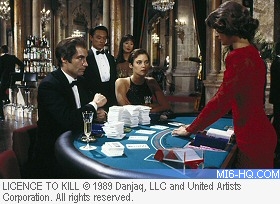
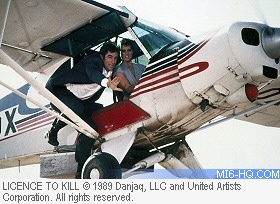
Above: Bond gets attention when
he turns up at the Isthmus casino as a high roller (top),
Pam Bouvier pilots Bond on to the top of a tanker.
|
As post-production got under way, the publicity
department set about creating the promotional posters for the
film, all emblazoned
with the title Licence Revoked. Before long, however, the title
had changed to the now more familiar Licence To Kill. The official
line was that Licence Revoked was proving too hard to translate
for non-English speaking territories, but it later emerged that
test
screenings in the States had left audiences puzzled - few of
them, it is said, understood what the word "revoked" actually
meant.
While the publicity
department set about changing all their hard work, new composer
Michael Kamen took up the baton and prepared
the new film's score. Kamen had already scored such international
box office hits as Lethal Weapon [1987] and Die Hard [1988]
(two of the films that Licence to Kill seemed so
desperate to
emulate) as well as collaborating with Eric Clapton on the
haunting
score
for TV's Edge of Darkness [1986]. Kamen decided not to follow
in the footsteps of his illustrious predecessor, John Barry
and
instead of asking a pop group to sing the title song, called
upon soul legend Gladys Knight to do the honours.
|
The British and world premiere on Tuesday
13 June 1989 was a predictable enough affair - it was held
at the Odeon Leicester
Square in the company of the Prince and Princess of Wales, the
last time the couple would grace a Bond premiere before
their
much publicised divorce and Diana's death in 1997. Though the
premiere was also attended by former Bond girls Jane
Seymour [Live
and Let Die [1973]] and Britt
Ekland [The Man With The Golden
Gun [1975]], there was a noticeable lack of interest in
the media
and the crowds that gathered outside the Odeon were noticeably
smaller than was usual for such events.
The film opened
in the States on 14 July
and found itself going head to head with a summer full
of blockbuster action movies, including Lethal Weapon
2, Indiana Jones and the Last Crusade and Batman.
Despite
EON's best efforts to endear the film to the American
market by setting it on their doorstep and filling
the
supporting
cast with American actors, Licence To Kill came
of worst in the summer box office battle. With admissions
dropping
to 11.7 million, the all-important Stateside gross
of $34,667,015 didn't even manage to cover the negative
costs
of $35 million. |
|
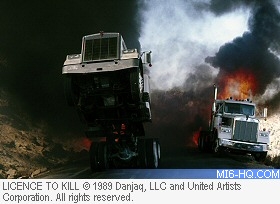
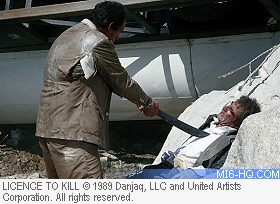
Above: The climactic finale sees the
destruction of Sanchez's drug shipment and a showdown with
Bond. |
The
worldwide gross for the film was also worryingly
low [just $156,200,000] and MGM/UA were starting to get nervous.
Broccoli
too was beginning to wonder if the fizz was going out of his
27-year old franchise. Not long after Licence To
Kill was released, Broccoli
put EON's parent company, Danjaq, up for sale. MGM/UA were still
interested enough in Bond to make preliminary advances on Danjaq
but were put off when Broccoli announced his asking price - a
hefty £200 million.
What happened next was to keep Bond off the screens
for another six years. But the lay-off seemed to do the trick
and when he
returned, in GoldenEye [1995], it was like watching a new man
- in more ways than one. |
|